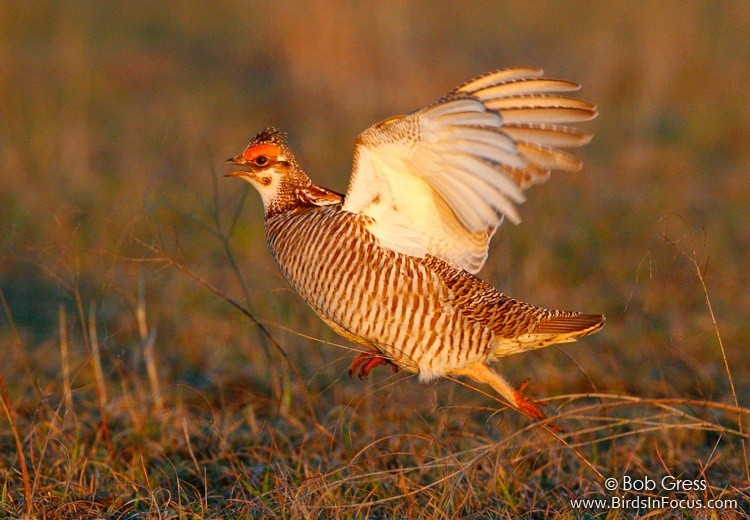Conserving Prairie-Chickens and their Habitat

The presence of prairie-chickens indicates healthy prairie landscapes. Their mating rituals are at the same time entertaining and uplifting. Every spring, generally from mid-March through mid-May, males gather in slightly elevated areas with sparse vegetation. They vigorously defend territories that seem hardly worth defending - each territory’s valuable resource is neither food nor nesting sites, but the males themselves. Physical battles at territory edges result in leks being littered with plucked-out feathers. Males advertise their fighting ability and overall good physical condition through an intricate display. It starts with the male lowering his head, raising his tail, and stomping his feet as fast as he can. Greater Prairie-Chickens are able to stomp their feet as many as 21 times per second (Augustine and Trauba 2015 Journal of Ethology)! The foot stomping culminates with two feathers being raised behind the head (called pinnae), inflation of a colorful air sac in the throat, and a loud vocalization. Both Greater and Lesser Prairie-Chickens do this display behavior, but they differ in the color of the air sac and the sound of the terminal vocalization. Lesser Prairie-Chickens have a magenta air sac and emit a short, higher-pitched ‘pop’ vocalization. Greater Prairie-Chickens have an orange air sac and emit a longer, lower-pitched 3-note ‘boom’ vocalization. Male Lesser Prairie-Chickens also have a unique ‘counter-singing’ display, not found in any other grouse species. Females visit these male display areas called ‘leks,’ mate, and raise the offspring on their own. Females seem to have the same taste in males – fewer than 20% of males successfully mate.
The presence or absence of prairie-chickens is an indicator of the quality of prairie and native rangeland management. It takes a diversity of native grassland plants to provide for the year round needs of either Greater Prairie-Chickens or Lesser Prairie-Chickens. Grazing practices, such as patch-burn patch-graze, are best for prairie-chickens because that management practice results in diverse habitat with different grass heights. Prairie-chickens require short grass for displaying, taller grass for nesting, and grass of intermediate height for raising chicks. The different grass heights attract a diverse suite of birds to the area. For example, Horned Larks and Savannah Sparrows prefer short grass; whereas, Henslow’s Sparrows prefer tall, thick grass. Intensive and homogeneous grazing (and annual burning of entire pastures) results in uniform structure or composition throughout and less suitable habitat for nesting, brood-rearing and other needs of prairie-chickens and many grassland species.
Audubon of Kansas is among several organizations that advocates for Environmental Quality Incentive Program (EQIP) funding for patch-burn grazing practices. AOK supports special Conservation Reserve Program and EQIP initiatives for Lesser Prairie-Chickens. AOK was the only organization that publicly challenged the claim made by the Kansas governor that the answer to Lesser Prairie-Chicken conservation was to raise them in captivity (thus, eliminating the need to protect habitat from various developments), and to strongly denounce the legislation promoted by former Secretary of State Kris Kobach that would have made it a crime for agency personnel in Kansas to assist the US Fish and Wildlife Service to conserve the species if it was designated as a federally threatened species! Most recently, Audubon of Kansas wrote a letter supporting the listing of Lesser Prairie-Chickens as endangered in New Mexico and Texas and as threatened in Kansas, Oklahoma, and Colorado under the Endangered Species Act.
Related Articles
- AOK Letter in Support of USFWS Listing of Lesser Prairie-Chicken
- Greater Prairie-Chickens have Become an Indelible, Irreplaceable Part of Our Ranch by William R. Browning, MD
- Prairie Burning Practices as a Factor in the Demise of the Prairie-Chicken by Bill Browning
- Potential Benefits of Patch Burning for prairie-chickens by Bill Browning
